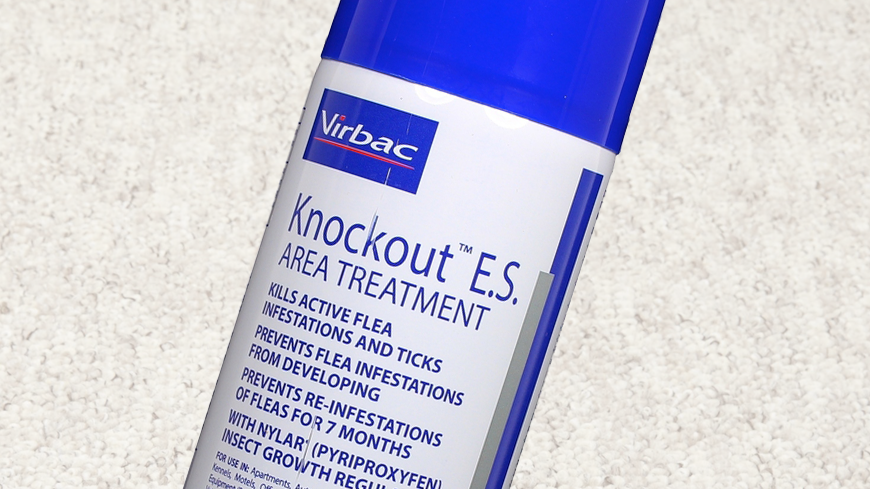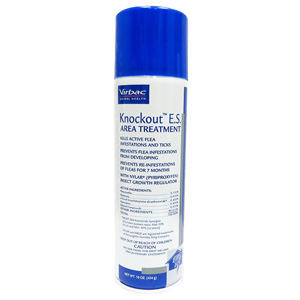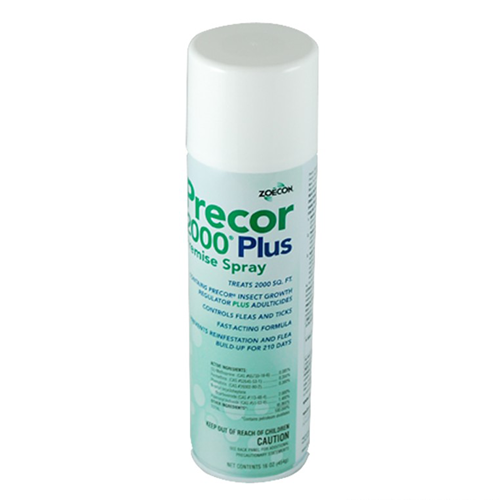Summary
Virbac Knockout E.S. is an insecticidal premise spray used for controlling fleas indoors. Pyrethrins rapidly kill adult fleas. And pyriproxyfen (Nylar) stops eggs and larvae from becoming adults. Pyriproxyfen remains active indoors for 7 months to prevent re-infestation.
Virbac Knockout E.S.
Virbac Knockout E.S. controls and prevents fleas indoors for 7 months.
Many premise sprays are similar to Virbac Knockout in terms of active ingredients. Thus, they have comparable performance. The main difference is price, and Precor 2000 Plus offers the best value.
| Product name | Virbac Knockout E.S. Area Treatment |
| Active ingredients | 0.100% pyriproxyfen 0.050% pyrethrins 0.400% permethrin 0.400% MGK 264 0.035% related compounds 99.015% other ingredients |
| Target pest | Fleas |
| Kills | Adults, eggs & larvae |
| Duration | 7 months |
| Size | 16 ounces |
| Capacity | 2100 sq ft |
| Application | Aerosol spray |
| Use on | Home premises |
| Manufacturer | Virbac |
| UPCs | 891962001347 719279587838 |
| Product label | view |
| MSDS | view |
| Shop | Amazon.com |
| Price | $25 |
| Customer reviews | Read reviews |
| Competitors | Browse premise sprays |
- Prices are based on Amazon.com at time of publishing.
Details
How Virbac Knockout E.S. Works
Pyriproxyfen
95-99% of flea populations are eggs, larvae, and pupae living in the environment. Thus, compounds that target these stages are crucial for premise sprays. In Knockout E.S., pyriproxyfen (Nylar) fills this role. Pyriproxyfen is an insect growth regulator (IGR). It works by mimicking a hormone in insects that regulates development. When exposed, eggs and larvae are unable to mature into adults. And adult females aren’t able to lay viable eggs.
What makes IGRs, like pyriproxyfen, effective for flea control is their long residual effect (7 months indoors). Most immature flea stages live at the base of carpeting, where sprays can’t penetrate well. Traditional insecticides don’t work well, because of their short-lived effect combined with this penetration problem. The extended duration of IGRs ensures that new eggs falling onto the carpets are rendered sterile, so new generations can’t take hold for 7 months.
Pyrethrins & Permethrin
The adulticides in Virbac Knockout are pyrethrins and permethrin. Both are derivatives of pyrethrum, an organic insecticide found in Chrysanthemum flowers. Pyrethrins are synthetic organic compounds. Permethrin is a pyrethroid insecticide, which are synthetically altered to be more chemically stable. Pyrethrins and pyrethroids target the nervous system of insects, resulting in spasms, paralysis, and ultimately death.
Adult fleas will quickly die when Virbac Knockout E.S. is sprayed. Unfortunately, only 1-5% of flea infestations consist of adults. And most adults live permanently on their animal host. Only a few adults that have recently emerged from their cocoons will be found in the environment. This is why adulticides are less important than the IGR in premise sprays.
Immature stages living deep within carpeting won’t be affected much by the adulticides. The carpet canopy protects them from spray penetration and vacuum removal. Many of the young fleas present at the time of spraying will survive to emerge as adults. This can make it seem like the spray was ineffective. However, this will be last generation of emerging adults. Further eggs that fall onto the IGR-treated carpets won’t survive.
MGK 264
N-octyl bicycloheptene dicarboximide (MGK 264) is a synergist. Synergists aren’t insecticides themselves, but they enhance the potency of pyrethrins and pyrethroids. Thus, they are often found in insecticide products together, such as Virbac Knockout. Synergists allow less insecticide to be used, which results in cheaper and safer products.
Precor 2000 Plus
Precor 2000 Plus is slightly cheaper than Virbac Knockout (may change).
Competitor Comparison
Virbac Knockout’s main competitors are Precor 2000 Plus, PT Ultracide, and Siphotrol Plus II. All of these products are aerosol premise sprays with similar active ingredient formulations. Price is the primary difference between them, and Precor 2000 Plus is the cheapest choice.
Instructions
The following instructions were taken from the product label of Virbac Knockout E.S. Before using the product, view the label for the full directions and precautionary statements.
READ ENTIRE LABEL BEFORE EACH USE.
DIRECTIONS FOR USE:
It is a violation of Federal law to use this product in a manner inconsistent with its labeling.
SHAKE WELL BEFORE USE.
STORAGE AND DISPOSAL
Do not contaminate water, food or feed by storage or disposal.
STORAGE: Store in a cool dry place away from heat or open flame and inaccessible to children.
PESTICIDE DISPOSAL: Wastes resulting from use of this product may be disposed of on site or at an approved waste disposal facility.
CONTAINER DISPOSAL: Do not puncture or incinerate! Empty container by using the product according to the label directions. Offer empty container for recycling, if available, or place in trash if allowed by state and local regulations. If container is partly filled, contact your local waste agency or call 1-800-CLEANUP for disposal instructions.
GENERAL INFORMATION
KNOCKOUT E.S. Area Treatment kills fleas and prevents flea infestation for a full season. Prevents re-infestation for seven months. Adult fleas may be seen in the treated areas when brought in on infested animals or when adults emerge from the pupal cases; however, a population will not develop in the treated area. In transportation equipment, certain plastics may be whitened or dulled. Apply only to carpets and cloth-upholstered areas, or test an inconspicuous area before treating.
Use KNOCKOUT E.S. Area Treatment at the rate of 16 oz. for up to 2100 sq. ft. (8 oz. for up to 1050 sq. ft.). Carpeted areas may be vacuumed before treatment and after treatment has dried. Treat infested areas or areas which could be infested; these include rugs, carpets, upholstered furniture, pet beds and pet resting areas. Hold can at arm’s length and direct spray toward the area to be treated. Use a sweeping motion to apply product and back away from treated area while holding the can 36 inches away from the surface being treated. Area of 80-100 sq. ft. can be treated in approximately 10 seconds with KNOCKOUT E.S. Area Treatment. When treating upholstered furniture, treat under cushions and areas where flea development occurs. Cover aquariums and fish bowls and remove birds from area prior to treating. Treated areas should be vacated during application. EXCEPT FOR APPLICATOR, DO NOT PERMIT HUMANS OR PETS TO CONTACT TREATED SURFACES UNTIL THE SPRAY HAS DRIED. DO NOT TREAT PETS WITH THIS PRODUCT.
FOR USE IN AND AROUND: Apartments, automobiles, homes, hospitals, hotels, kennels, motels, offices, schools, supermarkets, transportation equipment (buses, boats, ships, trains, trucks), warehouses, utilities, veterinary clinics and other commercial and industrial buildings.
NOTICE: KNOCKOUT E.S. Area Treatment has been tested on several types of carpet, fabric and other household furnishings without adverse effects. In a few instances, waxed surfaces have been whitened or dulled. Holding the can 36 inches away from the target surface normally prevents any whitening from occurring. Because of the wide variety of floor types and finishes, treat a small inconspicuous area before treating the entire area. Avoid contact with antique finishes.
Tips for Success
Target Hot-Spots
Flea eggs are laid on animals, but they’re non-sticky and soon fall. The eggs can drop anywhere the infested pet wanders, but most end up in favored resting locations. Hot-spots tend to develop where dogs and cats eat, groom, and sleep. In bedrooms, hot-spots occur near beds. In living rooms, fleas are often found where pets lay next to furniture.
When spraying Virbac Knockout, be thorough and spray the entire floor of infested rooms, but give special attention to potential hot-spots. If follow-up treatments are needed, spraying can be limited to the hot-spots where the majority of fleas are seen.
Have Realistic Expectations
Having realistic expectations about flea control can help reduce stress. No product or method will end an infestation immediately. After spraying, new eggs falling onto the floors shouldn’t be able to survive. So there won’t be a new generation. However, many immature fleas currently in the carpets may survive. They live deep within the fibers where sprays and vacuums can’t reach. The infestation won’t be over until all of these stages mature, emerge, and die. It usually takes around 2 months before an infestation ends. Seeing new adults until this time is normal, but it can confuse users into thinking the spray was ineffective.
Pre-Emerged Adults
After reaching maturity, adult fleas can elect to stay inside their cocoons and enter into a sleep-like (quiescent) state for up to 5 months. This extended longevity of cocooned adults can cause control issues. Vacuuming is one of the best ways to force these adults to wake up and emerge. Heat and pressure cause emergence, as they indicate that a host is resting on the cocoon. Vacuuming simulates these host cues.
Vacuuming Procedure
Thoroughly vacuum the carpets before spraying. Vacuuming lifts up the carpet fibers, allowing the insecticide to penetrate deeper. Don’t vacuum again until the spray dries. Then employ a regular routine, vacuuming about once every other day. Studies show that flea insecticides shouldn’t be affected by dry vacuuming. Vacuuming may actually improve efficacy by causing adults to emerge from their cocoons into the adulticide.
Premise Sprays Aren’t Enough
Adult fleas account for 1-5% of infestations and live on pets. They won’t leave a host once it’s acquired. So, even with carpets treated, the adult fleas will continue to thrive on untreated pets. Each female flea will lay around 25 eggs a day. Flea eggs fall anywhere the animal can access. If eggs fall onto an untreated surface, then the infestation will continue to grow.
This is why an integrated approach is the best way to control fleas. Treat the environment, treat pets, and establish a regular vacuuming routine. This kind of regime is the easiest and fastest way to establish and maintain control.







You must log in to post a comment. Log in now.
I used the product. I was pleased, then last night I was bitten several times in bathroom. My bathroom is large and tile. I followed up earlier today with reapplying the product in bathroom. My question is should I apply product to my apartment entirely again? Its a small apartment. Thanks!
The most important ingredient is the IGR, which will last for 7 months indoors. You shouldn’t need to re-apply, but you can if you feel it is necessary.
It’s normal to see some fleas after treatment. This is because immature stages live in protected microhabitats, where treatments can’t reach well. So they may survive to emerge as adults. However, they should be the last generation, because new eggs that fall onto the treated surfaces won’t survive. It usually takes around 8 weeks before fleas are completely gone.
Is this safe to use on my own bed? My dog tends to cuddle me when I’m sleeping and I have found a couple of fleas. I have her on Nexgard now but I want to make sure this is safe for my sleeping arrangements as well.
It would be best not to use chemical pesticides directly where you are sleeping, especially when there are other options. While the compounds are tested and show low a toxicity of humans, why risk it? One alternative would be to wash your bedding more frequently. Laundering the bedding will kill any potential fleas. Or you can prevent the dog from sleeping on your bed altogether.
I am trying to decide between the Virbac Knockout E.S. area spray (lasts for 7 months) and the regular Virbac Knockout Spray (lasts for 4 months). They seem to be the same product but different ingredients? Can you offer any advice? thankyou
I believe the E.S. stands for “extra strength”. They have different ingredients, as you mentioned. What makes the E.S. version last 3 more months is the concentration of the insect growth regulator (IGR) ingredient (pyriproxyfen). Knockout has 0.015% pyriproxyfen, and Knockout E.S. has 0.100% pyriproxyfen.
I have asthma and dry eye, and I suppose I can buy a respirator & wear goggles during application. My concern is how do I rid myself of fleas without harming myself? Also, how long does it take to dry before my cat & I can return to my apartment? Lastly, most of my apartment are hardwood floors. If I am to understand these instructions, I am not to spray over my hardwood floors, but just spray under and over my furniture cushions and area rugs. After reading this post, I will probably throw away the area rug underneath my bed. So those are my 3 questions related to my protection, drying time, and hardwood floors.
First of all, I am not a retailer or manufacturer of this product. Information I provide may not be accurate. My answers will be based on the instructions and my general understanding.
It should be safe to apply the product in a way that adheres to the labeled directions. However, with your asthma and dry eye, it may be a good idea to take the extra precautions you mentioned.
it shouldn’t take more than a few hours to dry if the area is well ventilated. When applying, it should be applied in a sweeping motion until the area is slightly damp. Don’t over-apply the insecticide to the point where the carpet is wet and saturated.
I’m not sure where you’re reading not to spray hardwood floors. I think it specifically mentions carpets, rugs, pet beds, and cushions because these are common potential flea hot-spots. That said, it should be effective on hardwood floors. However, there are less areas where fleas can develop on hardwood. Flea larvae must have a dark, protected environment to live in. So, focus on cracks and crevices, and areas where debris collects.
Considering using Knockout ES for flea control. My 2 year old grandson lives in the home. I have been told by our vet that the treatment is ok around children once it dries & to keep him off the carpet for 3 days or so. I’m still concerned about the insecticides in it. What are your thoughts? Thanks!
It should be safe to use if the directions are adhered to. Using only an IGR may be a safer option, as it only contains the IGR ingredient and not the other traditional pesticides. IGRs are insect hormone mimics, so they are considered safer than traditional insecticides for mammals. For example, Martin’s IGR.